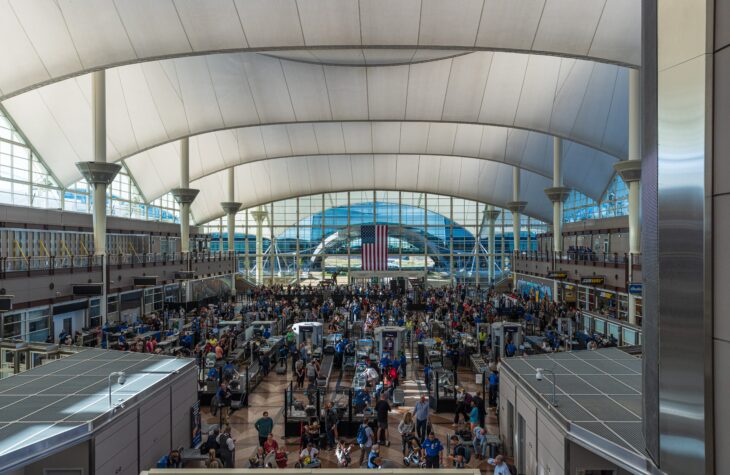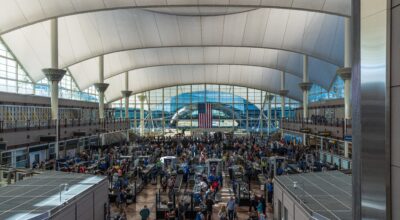
Primer: Modernizing Aviation Security
The Transportation Security Administration (TSA), established in the aftermath of the September 11, 2001, terrorist attacks, is tasked with ensuring the security of U.S. transportation systems, particularly air travel.1 However, its government-operated model has faced criticism for inefficiencies, inconsistent performance, and high costs. On October 1, 2025, the U.S. government shut down after Senate Democrats refused to pass a clean continuing resolution to fund the government. The shutdown made commercial air travel more difficult for Americans because TSA workers and air traffic controllers did not come to work due to missed paychecks. Expanding the existing Screening Partnership Program, which allows qualified private companies to provide security screening services at commercial airports, would ensure that airport security remains intact and continues to operate during long lapses in appropriations.
Inefficiencies and Inconsistent Performance
Government reports dating back to 2012 have documented TSA wasting hundreds of millions of taxpayer dollars.2 For example, in 2012, the House Committee on Transportation and Infrastructure and the House Committee on Oversight issued a report entitled Airport Insecurity: TSA’s Failure to Cost-Effectively Procure, Deploy and Warehouse Its Screening Technologies, in which committee staff asserted that “delayed deployment of TSA’s state-of-the-art screening technologies resulted in a massive depreciated loss of equipment utility at an estimated cost to taxpayers of nearly $23 million.”3 In 2017, Department of Homeland Security (DHS) inspectors conducted undercover tests to assess the effectiveness of TSA screeners.4 DHS found that TSA screeners failed more than 70 percent of the time when it came to spotting undercover officers with mock knives, guns, and explosives.5 According to another congressional report from the House Committee on Homeland Security entitled Misconduct at TSA Threatens the Security of the Flying Public, almost half of TSA’s workforce allegedly committed some form of misconduct.6 DHS’s inspector general’s office has published a collection of reports detailing an extensive history of wastefulness and negligence.7 Some examples include the following:
- CBP, ICE, and TSA Did Not Fully Assess Risks Associated with Releasing Noncitizens Without Identification into the United States and Allowing Them to Travel on Domestic Flights (September 30, 2024)
- Under President Joe Biden, TSA’s vetting procedures could not protect American citizens from dangerous illegal aliens.
- “Under current processes, CBP and ICE cannot ensure they are keeping high-risk noncitizens without identification from entering the country. Additionally, TSA cannot ensure its vetting and screening procedures prevent high-risk noncitizens who may pose a threat to the flying public from boarding domestic flights.”
- “Under current processes, CBP and ICE cannot ensure they are keeping high-risk noncitizens without identification from entering the country. Additionally, TSA cannot ensure its vetting and screening procedures prevent high-risk noncitizens who may pose a threat to the flying public from boarding domestic flights.”
- Under President Joe Biden, TSA’s vetting procedures could not protect American citizens from dangerous illegal aliens.
- Vulnerabilities Continue to Exist in TSA’s Checked Baggage Screening (August 18, 2022)
- The inspector general identified vulnerabilities in TSA’s screener performance. Unfortunately, details related to the testing results presented in the report are classified.
- “The Inspector General’s office conducted covert tests to determine the effectiveness of TSA’s checked baggage screening technologies, related procedures, and whether Transportation Security Officers complied with screening policies and procedures. We identified vulnerabilities with TSA’s screener performance, associated procedures, and screening equipment.”
- “The Inspector General’s office conducted covert tests to determine the effectiveness of TSA’s checked baggage screening technologies, related procedures, and whether Transportation Security Officers complied with screening policies and procedures. We identified vulnerabilities with TSA’s screener performance, associated procedures, and screening equipment.”
- The inspector general identified vulnerabilities in TSA’s screener performance. Unfortunately, details related to the testing results presented in the report are classified.
- DHS Did Not Effectively Oversee TSA’s Acquisition of Computed Tomography Systems (September 23, 2021)
- TSA does not conduct acquisition processes properly.
- “TSA acquired CT systems [X-ray scanning equipment] that did not address all the needed capabilities. These issues occurred because the Department of Homeland Security did not provide adequate oversight of TSA’s acquisition of CT systems. The result of this is that TSA risks spending over $700 million in future appropriated funding to purchase CT systems that may never fully meet operational mission needs.”
- “TSA acquired CT systems [X-ray scanning equipment] that did not address all the needed capabilities. These issues occurred because the Department of Homeland Security did not provide adequate oversight of TSA’s acquisition of CT systems. The result of this is that TSA risks spending over $700 million in future appropriated funding to purchase CT systems that may never fully meet operational mission needs.”
- TSA does not conduct acquisition processes properly.
Future privatization is necessary to ensure the safety of commercial air travel and boost the economy. A private model or increased partnerships with the private sector would decrease operational costs and provide a better response to security threats and problems. According to research from Tourism Economics, current inefficiencies and shortcomings at TSA also cause dire economic consequences.8 For example, as a result of inefficient and frustrating airport security processes, an estimated three million trips could be lost, resulting in spending losses of $7.4 billion over the next year.9 An improved and privatized security process would likely create faster screening times, which would allow passengers to spend more time in airport concourses, where they could patronize more businesses and make their flights on time.
Given the political realities in Congress, the first step should be expanding the Screening Partnership Program. As mentioned above, the Screening Partnership Program (49 U.S.C. § 44920) contracts security screening services at commercial airports to qualified private companies.10 These companies run screening operations under federal oversight.11
Screening Partnership Program and Reforms
Under the Screening Partnership Program, contractors perform screening under the direction of TSA and must meet specific performance standards. TSA’s website lists twenty airports that are currently enrolled in the program, with two of the largest being San Francisco International Airport and Orlando Sanford International Airport. The Government Accountability Office has estimated that the program cut costs for participating airports by 11 percent compared to TSA’s screening.12 However, the growth in the number of airports opting for private screeners has not been substantial because the contracting process is complicated and burdensome.13 For example, under the current program rules, an airport seeking a contract must submit a detailed request to TSA, and if TSA decides to grant that airport entry into the program, it will then determine which security company it believes best fits the needs of the airport applicant.14 In short, the airport has only a minor advisory role in the selection process. In the 118th Congress, Senator Mike Lee (R-UT) introduced the Screening Partnership Reform Act, which would fix many of these problems.15 For example, according to a press release from Lee’s office,16 the bill would
- Statutorily require TSA’s cost estimation process to account for total costs to the federal government
- Give airport operators a role in selecting a private screening company for their airport
- Allow private screening companies to conduct on-site training rather than requiring them to travel to a Federal Law Enforcement Training Center
- Allow private screening companies to submit recommendations to TSA on new and innovative approaches to screening
- Clarify ambiguities in hiring practices during the transition from TSA to private screening
Lee also has introduced another bill to fully privatize and abolish TSA.17 The Abolish the TSA Act would dissolve TSA and facilitate the transfer of screening activities to the private sector.
Conclusion
Congress should consider expanding the Screening Partnership Program, which would be a step toward improving TSA’s efficiency. By allowing more airports to opt for private security contractors, the program can reduce passenger wait times, enhance customer satisfaction, and lower operational costs.
Endnotes
1. Elias, Bart; Frittelli, John; Goldman, Ben; Jaikaran, Chris; Marshall, Jennifer J.; Parfomak, Paul W. (May 23, 2025). “Transportation Security: Background for the 119th Congress,” Congressional Research Service. https://www.congress.gov/crs-product/R48543?q=%7B%22search%22%3A%22Transportation+Security+Administration%22%7D&s=2&r=11
2. Joint Majority Staff Report (May 9, 2012). “Airport Insecurity: TSA’s Failure to Cost Effectively Procure, Deploy and Warehouse Its Screening Technologies,” House Committee on Oversight and Government Reform and House Committee on Transportation and Infrastructure. https://oversight.house.gov/wp-content/uploads/2012/05/5-9-2012-Joint-TSA-Staff-Report-FINAL.pdf
3. Ibid.
4. CBS Mornings (November 9, 2017). “TSA Screenings Fail to Spot Weapons Most of the Time, Agency Says,” CBS News. https://www.cbsnews.com/news/tsa-screenings-fail-to-detect-explosives-guns-knives-70-percent/
5. Ibid.
6. Perry, Scott and Katko, John (July 2016). “Misconduct at TSA Threatens the Security of the Flying Public,” House Committee on Homeland Security.
7. Office of Inspector General (accessed November 12, 2025). “TSA,” U.S. Department of Homeland Security. https://www.oig.dhs.gov/taxonomy/term/5
8. Research Report (December 2023). “U.S. Travel Association Policy Priorities: Quantitative Research,” Tourism Economics. https://www.ustravel.org/sites/default/files/2024-01/2023-11-te-oxford-us-travel-policy-priorities.pdf
9. Ibid.
10. Program Description (accessed November 12, 2025). “Screening Partnership Program,” Transportation Security Administration. https://www.tsa.gov/for-industry/screening-partnerships
11. Ibid.
12. GAO Report (November 2015). “TSA Can Benefit from Improved Cost Estimates,” Government Accountability Office. https://www.gao.gov/assets/gao-16-19.pdf; Press Release (March 24, 2023). “Sen. Lee Introduces Bills to Improve U.S. Aviation Industry, Office of Sen. Mike Lee.
https://www.lee.senate.gov/2023/3/sen-lee-introduces-bills-to-improve-u-s-aviation-industry
13. Scribner, Marc (October 13, 2025). “Reforming the TSA so Airport Security Isn’t Impacted by Government Shutdowns,” Reason Foundation. https://reason.org/commentary/reforming-tsa-airport-security-government-shutdowns/
14. Ibid.
15. Press Release (March 24, 2023). “Sen. Lee Introduces Bills to Improve U.S. Aviation Industry,” Office of Sen. Mike Lee. https://www.lee.senate.gov/2023/3/sen-lee-introduces-bills-to-improve-u-s-aviation-industry
16. Ibid.
17. Press Release (March 27, 2025). “Tuberville, Lee Introduce Legislation to Abolish TSA,” Office of Sen. Mike Lee. https://www.lee.senate.gov/2025/3/lee-and-tuberville-introduce-bill-to-abolish-the-tsa




